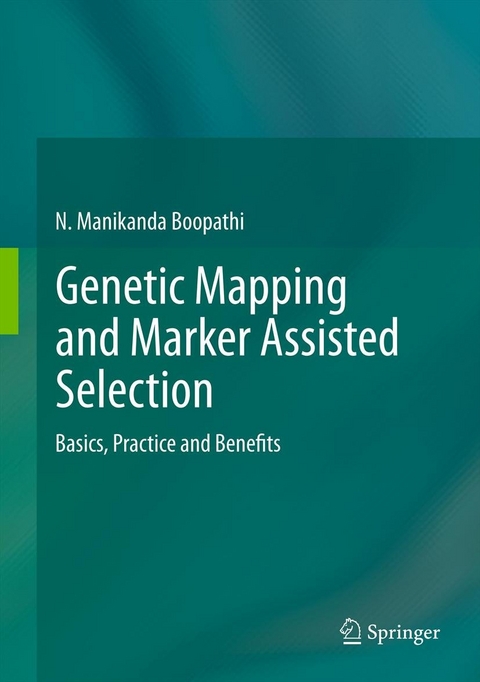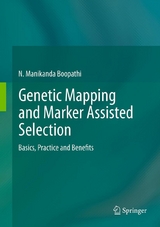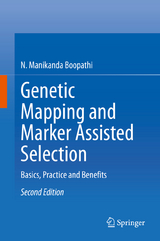Genetic Mapping and Marker Assisted Selection
Springer, India, Private Ltd (Verlag)
978-81-322-0957-7 (ISBN)
- Titel erscheint in neuer Auflage
- Artikel merken
Genetic mapping and marker assisted selection (MAS) is considered as one of the major tools in genetic improvement of crop plants in this genomics era. This book describes basics in linkage mapping, step-by-step procedure to perform MAS, achievements made so far in different crops, and limitations and prospects of MAS in plant breeding. It summarizes all this in a simple but comprehensive mode using suitable examples so as to explain the concept and its historical developments. To summarize, this book describes technologies for identification of genes of interest through genetic mapping, recaps the major applications of MAS to plant breeding; lists examples in which MAS is being applied to various breeding programs, and emphasizes the various difficulties that limit the application of MAS in plant breeding, providing possible solutions to overcome these difficulties, and finally tries to illustrate the future prospects.
This book would be a valuable guide to the under-graduates and post-graduates of agricultural universities and institutes that are interested and/or involved in genetic improvement of crop plants using modern tools. Bibliography listed in this book constitutes two parts: literature cited and further reading. Literature cited contains references cited in the text and further information on the given concept/technique can be obtained from these references. Further reading provides a list of suggested readings for in-depth coverage of the topics.
N. Manikanda Boopathi is presently working as an Assistant Professor (Biotechnology) at the Department of Plant Molecular Biology and Biotechnology, CPMB&B, Tamil Nadu Agricultural University, Coimbatore, India. He graduated in agricultural sciences, did his masters and doctoral studies in Plant Biotechnology and trained at International Rice Research Institute, The Philippines. He has handled more than 20 courses for under-graduate and post-graduate students in his university and is invited frequently for delivering lectures in several institutions, both in India and abroad. His scientific work has been recognized during several occasions and has brought him laurels and awards. He has a vast experience in QTL mapping and marker assisted selection in rice and cotton. He has completed several national and international research projects and is currently working in two countrywide and one worldwide network projects that address the problems of biotic and abiotic stresses in cotton, mungbean, hot-pepper and tomato using system quantitative genetics. His publications can be found at http://sites.google.com/site/drnmboopathi and/or http://tnaucottondatabase.wordpress.com/.
1.Germplasm Characterization: Utilizing the Underexploited Resources.- i)Phenotyping for morphological and agronomic traits.- i) Case study in rice germplasm characterization for drought resistance: Formation of fundamental requirements.- ii) Traits useful for characterization.- b)Allele mining.- c) Genetic diversity and Clustering.- i) Software.- ii) Principle behind the genetic diversity analysis.- iii) Principle of measuring goodness-of-fit of a classification.- d) Genetic Diversity analysis using molecular markers.- e) Parental selection.- 2. Mapping Population Development.- a)Mapping population and its importance in genetic mapping.- b) Selfing and Crossing techniques in crop plants.- c) F2 progenies.- d) F2 derived F3 (F2:3) populations.- e) F2 inter-mattingor immortalized F2 populations.- f)DH lines.- g) BC progenies.- h) RILs.- i) NILs, Exotic libraries and advanced backcross populations.- j) Four-way cross population.- k) Multi-cross populations.- l) Nested association mapping populations.- m) Natural populations.- n) Chromosome specific genetic stocks for linkage mapping.- o) Combining Markers and Populations.- p) Characterization of Mapping Populations.- q) Choice of Mapping Populations.- r) Challenges in mapping population development and solutions to these challenges.- s) Bulk Segregant Analysis.- 3. Genotyping.- a) Markers and its importance.- b)Morphological markers.- c) Biochemical markers or Isozymes.- d) Genome structure and organization.- e) Molecular markers.- f) RFLP.- g) Arbitrarily primed PCR-based markers.- i) RAPD.- ii) AP-PCR and DAF.- iii) AFLP.- h)Sequence specific PCR based markers.- i) Microsatellite based marker technique.- ii) SNP.- iii) SFP.- iv) SCAR.- v) CAPS and dCAPS.- vi) RAMP.- vii) SRAP.- viii) TRAP.- i) Single strand conformation polymorphism.- j)Transposable elements (TE) based molecular markers.- k) Diversity Array Technology (DArT).- l) Intron-Targeted Intron-Exon Splice Conjunction (IT-ISJ) Marker.- m) Restriction site associated DNA (RAD) markers.- n) RNA-based molecular markers.- o) Role of genomics.- p) Selection of Marker Technology.- q) Marker Genotyping and Scoring.- r) Analyzing the genotype score: Chi-square test.- s) Χ2 test to analyze the segregation ratio using the program ANTMAP.- 4. Linkage Map Construction.- a)Basics of linkage mapping: Mendelian rations, meiosis, crossing over and partial linkage.- b) Mapping function.- c) Mapping of genetic markers: genetic consideration.- d) Testing of linkage: LOD scores.- e) Grouping, ordering and spacing.- f) Sources of error.- g) Chromosomal assignment.- h)Allopolyploidy and autopolyploidy.- i) Bridging linkage maps to develop unified linkage maps.-5. Phenotyping.- a) Phenotyping vs. QTL mapping.- b) Need for precise phenotyping.- c) Phenotyping for biotic stress.- d)Phenotyping for abiotic stress.- e) Heritability of phenotypes.- f)Statistical analysis of phenotypic data: simple statistics, heritability estimation and correlation.- 6. QTL Identification.- a) QTL: a prelude.- b)Single marker analysis.- c) Interval mapping.- d) Multiple QTL and methods to detect multiple QTL.- e) Composite interval mapping.- f) Multiple trait mapping.- g) Testing for linked vs. pleiotropic QTLs.- h) Multiple interval mapping or multiple QTL mapping.- i) Statistical significance.- j)Permutation testing.- k) Bootstrapping.- l) Permutation vs. bootstrapping and other methods.- m) QTL x QTL interaction: impact of epistasis.- n)QTL x Environment interaction.- o) Congruence of QTLs: across the environments and across the genetic backgrounds is the key in MAS.- p)Meta-QTL analysis.- q) Concluding remarks on QTL methods.- r)Alternatives in classical QTL mapping.- s) Bulked segregant analysis and selective genotyping.- t) Genomics assisted breeding.- u) Array mapping.- v) Association mapping.- w) Nested association mapping.- x) EcoTILLING.- y) Challenges in QTL mapping.- 7. Fine Mapping.- a) Need for fine mapping or high resolution mapping.- b) Types of markers suitable for fine mapping.- c) Physical mapping and its role in fine mapping.- d) Comparative mapping.- e) Genetical genomics or eQTL mapping.- f) Map based cloning.- g)Validation of QTL.- h) Testing the markers in related germplasm accessions.- 8. Marker Assisted Selections.- a) Advantages of MAS.- b)Limitations in MAS.- c) Prerequisites for an efficient marker assisted program.- d) Procedure for generalized MAS program for selection from breeding lines / populations.- e) Marker assisted back cross breeding.- f)Gene pyramiding or stacking.- g) Accelerated methods of gene pyramiding.- h) Marker assisted recurrent selection.- i) AB-QTL.- j)Mapping-as-you-go.- k) Application of markers in germplasm storage, evaluation and use.- l) Resources for MAS on the web.- 9. Success Stories in MAS.- a) Tomato.- b) Maize.- c) Wheat.- d) Rice.- e) Barley.- f) Soybean.- g) Varieties released through MAS.- h) Hybrids released through MAS.- i)MAS in multinational companies.- j) Contrasting stories.- k)Conclusions and future prospects.- 10. Advances in MAS toward genetically improved crop plants.- a) Molecular breeding platforms: Techniques in molecular, biochemical and physiological studies and its integration into MAS.- b)Molecular techniques.- c) Expression profiling.- d) cDNA library construction.- e) Differential display and representational difference analysis.- f) Subtractive hybridization.- g) Microarray.- h) Nucleic acid sequencing.- i) Serial analysis of gene expression (SAGE).- j)cDNA-AFLP.- k) RFLP coupled domain directed differential display (RC4D).- l)Gene tagging by insertional mutagenesis.- m) Post transcriptional gene silencing.- n) microRNAs.- o) Biochemical techniques.- p) Why proteomics?.- q) Type of proteomics.- r) Protein analysis.- s) One – and two - dimensional gel electrophoresis .- t) Alternatives to electrophoresis in proteomics.- u)Acquisition of protein structure information.- v) Edman sequencing.- w)Mass spectrometry.- x) Types of mass spectrometers.- y) Peptide fragmentation.- z) De novo peptide sequence information.- aa)Uninterpreted MS/MS data searching.- bb) Proteomics approach to protein phosphorylation.- cc) Phosphoprotein enrichment.- dd)Phosphorylation site determination by Edman sequencing.- ee)Phosphorylation site determination by mass spectrometry.- ff) Metabolite profiling technologies.- gg) Physiological techniques.- hh) Near infrared spectroscopy.- ii) Canopy spectral reflectance (CSR) and infrared thermography (IRT).- jj) Estimation of compatible solutes.- kk) Genomics assisted breeding.- ll) Functional markers.- mm) Comparative genomics.- nn) Identification of novel molecular networks and construction of new metabolic pathway.- oo) Bioinformatics for MAS.- 11. Recent advances in MAS in major crops.- a) Rice.- b) Cotton.- c) Mungbean.- d) Tomato.- e)Hot-pepper.- 12. Future perspectives in MAS.- a) MAS in orphan crops.- b)MAS in developing countries.- c) Community efforts and their implications in MAS.- d) Field and laboratory infrastructure improvement.- e) Lessons learnt and concluding remarks.
| Zusatzinfo | 8 Tables, black and white; XV, 293 p. |
|---|---|
| Verlagsort | New Delhi |
| Sprache | englisch |
| Maße | 178 x 254 mm |
| Gewicht | 7318 g |
| Themenwelt | Naturwissenschaften ► Biologie ► Botanik |
| Schlagworte | genetic diversity • linkage mapping • Marker assisted selection • Molecular Breeding • QTL mapping |
| ISBN-10 | 81-322-0957-5 / 8132209575 |
| ISBN-13 | 978-81-322-0957-7 / 9788132209577 |
| Zustand | Neuware |
| Informationen gemäß Produktsicherheitsverordnung (GPSR) | |
| Haben Sie eine Frage zum Produkt? |
aus dem Bereich





